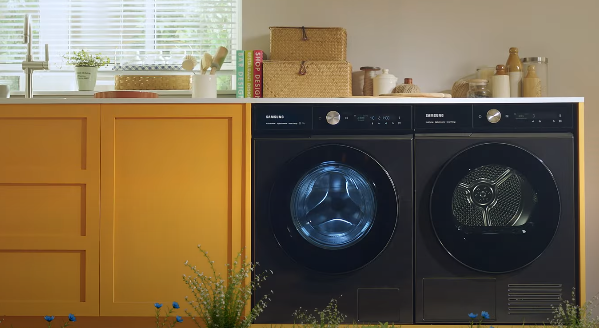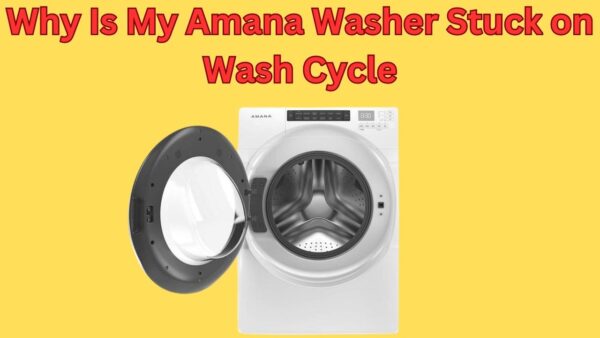If you’re dealing with a Samsung washer that’s not draining, you’re not alone. Many homeowners face this issue, and it can be both confusing and frustrating.
In this guide, we’ll explore 15 common reasons why your Samsung washer may not be draining properly.
From blockages in the drain hose to a faulty drain pump, we’ll delve into potential causes and offer practical advice to help you identify and potentially fix the issue, restoring your washer to optimal functioning.
Samsung Washer Not Draining

Blockages in the Drain Hose
Cause
One common reason for a Samsung washer not draining is a blockage in the drain hose.
Small clothing items, lint, or occasional debris can get lodged in the hose, preventing the water from draining out of the machine.
This buildup can happen over time or can result from a particularly bulky load.
Solution
To resolve this issue, first, turn off and unplug the washing machine to ensure safety.
Next, remove the drain hose and check for visible blockages. If you can see the obstruction, try to remove it, or you can use a plumber’s snake to dislodge it from the hose.
If you’re unable to remove the blockage or if it’s too far in the hose, it might be time to replace the drain hose.
Always remember to consult your washer’s user manual or a professional if you’re unsure about performing these steps.
Faulty Drain Pump
Cause
A faulty drain pump can be another reason why your Samsung washer is not draining.
The pump is an essential component that forces water out of the drum and through the drain hose.
If the pump is faulty, it may not be able to perform this function efficiently, leading to water remaining in your washer after a cycle.
Solution
If you suspect the drain pump is at fault, you might want to consider checking its condition.
Unplug your machine for safety, and access the pump (usually located at the bottom of the washer). Inspect it for signs of damage or mechanical failure. In some cases, you may be able to fix the issue by cleaning the pump.
However, if the pump is significantly damaged or worn out, it may need to be replaced. Be sure to consult your washer’s manual or a professional for assistance, as this task can be complex for those unfamiliar with washer repair.
Clogged Filter
Cause
A clogged filter is another typical cause of drainage issues in a Samsung washing machine.
The filter functions as a trap for lint, hair, and small pieces of fabric that may come off clothes during the wash.
Over time, these materials can accumulate and obstruct the filter, impeding the water drainage and causing the washer to retain water.
Solution
To fix a clogged filter, unplug the washing machine for safety reasons, then locate and remove the filter according to the machine’s manual.
Rinse it thoroughly under running water or use a soft brush to clear away any debris. Once the filter is clean and dry, place it back in the machine.
If the filter is damaged or excessively worn, consider purchasing a replacement. As always, if you’re unsure about any part of this process, consult your user manual or seek the assistance of a professional.
Excessive Detergent Use
Cause
Excessive use of detergent in your Samsung washing machine can lead to issues with draining.
When too much detergent is used, it can create excess suds during the wash cycle.
These suds can then clog the drain system, hindering the water from draining effectively.
Solution
To solve this problem, ensure you are using the correct amount of detergent recommended by both the detergent manufacturer and your washing machine’s manual.
Opt for HE (High Efficiency) detergents that produce fewer suds and are specifically designed for use in modern washing machines.
If you’ve used too much detergent, run an extra rinse cycle without any detergent to help remove excess suds. Always remember that when in doubt, less is more when it comes to detergent usage.
Incorrect Load Size
Cause
An incorrect load size can also lead to drainage issues with your Samsung washer.
Overloading the washer with clothes might prevent it from draining properly.
This is because an excessively heavy load can affect the balance of the drum and impede the pump’s ability to expel water effectively.
Solution
The solution to this issue is simple – ensure you’re loading your washer according to its capacity.
Refer to your machine’s user manual to understand the optimal load size. Avoid overloading the washer and ensure clothes have enough space to move freely during a wash cycle.
This not only helps with proper draining but also ensures your clothes are cleaned efficiently. In case of any uncertainties, it’s always advisable to seek professional advice.
Faulty Water Level Sensor
Cause
Another potential cause for your Samsung washer not draining could be a faulty water level sensor.
The water level sensor is responsible for determining the amount of water in the drum and signaling the machine to stop filling.
If this sensor is faulty, it may misread the water level, causing the machine to overfill or not drain correctly.
Solution
In case of a suspected faulty water level sensor, the best course of action is to have it inspected by a professional.
Unplugging the machine for safety, they would typically check the sensor for any signs of malfunction or damage.
If it’s found to be the problem, replacing the water level sensor is usually the most effective solution.
It’s important to note that due to the complexity and the need for precise calibration, this task should be left to professionals.
Damaged Drive Belt
Cause
A damaged drive belt is another common reason for a Samsung washer not draining correctly.
The drive belt is the component responsible for turning the drum during a wash cycle.
Over time, this belt can wear out or break, which can prevent the drum from spinning adequately and disrupt the proper drainage of water.
Solution
In case of a suspected damaged drive belt, you will need to inspect the belt’s condition.
Ensure to unplug the washer for safety before attempting any inspection or repair. If the belt is loose, worn out, or broken, it will need to be replaced.
Depending on your comfort level and proficiency with home appliances, you might be able to replace the belt yourself by referring to your washer’s user manual for guidance.
However, if you’re unsure, it is always advisable to seek the help of a professional.
Broken Timer
Cause
The timer in your Samsung washing machine plays a crucial role in controlling the sequence of washing operations.
It determines when to fill or drain water, agitate the clothes, and spin the drum.
If the timer is broken, it may not signal the machine to drain the water at the appropriate time, resulting in water remaining in the machine after a wash cycle.
Solution
Addressing a broken timer requires professional intervention. Start by unplugging the machine for safety reasons.
A professional technician will typically check the timer for any signs of damage or malfunction, such as scorched contacts or a faulty motor. In case the timer is indeed faulty, it will need to be replaced with a new one.
Given the complexity and specificity of this task, it’s recommended to leave this to a professional rather than attempting to fix it yourself.
Incorrect Washer Installation
Cause
The installation of your Samsung washing machine can significantly impact its ability to drain water correctly.
If the drain hose is too high, the water might not be able to reach the height of the drain and hence fail to evacuate properly.
Similarly, if the machine isn’t leveled correctly, it could prevent the water from draining effectively.
Solution
Ensure that your Samsung washer is installed as per the guidelines provided in the user manual.
The drain hose should be positioned at the correct height, and the washing machine should be leveled using the adjustable feet at the bottom of the machine.
If any uncertainty arises during the installation process, it’s recommended to consult a professional for assistance.
Drain Hose Extension Issues
Cause
A common cause for drainage issues in a Samsung washer is an issue with the drain hose extension.
This can happen when the hose is kinked, blocked, or not properly attached. This prevents water from flowing out of the machine, leading to ineffective drainage.
Solution
Resolving this issue involves inspecting the drain hose. Unplug the washing machine for safety, then check the hose for any kinks or blockages, and ensure it’s securely connected to the machine.
If the hose is damaged, it may need to be replaced. If you’re unsure about any steps or the issue persists, it’s advisable to contact a professional.
Worn Out Lid Switch Assembly
Cause
An often-overlooked cause for a Samsung washer not draining is a worn-out lid switch assembly.
The lid switch assembly is a safety mechanism that ensures the washer drum stops spinning when the lid is open.
Over time, this assembly can wear out or malfunction, causing the washer not to drain properly.
Solution
If the lid switch assembly is suspected to be the problem, a quick inspection can confirm it.
For safety, unplug the washer before any assessment. If the lid switch assembly is indeed worn out or broken, it will need replacing.
Given the technical detail involved in this task, it’s recommended to have this done by a professional to ensure proper installation and function.
Issues With the Drain Hose Height
Cause
The drain hose’s height can adversely affect your Samsung washer’s ability to drain water properly.
If the drain hose is installed too high, the washer may face difficulties pushing water upward and out of the machine, leading to ineffective drainage.
Solution
To rectify this issue, consult the installation guidelines provided in the user manual.
The drain hose should be installed at the recommended height, ensuring efficient water flow.
If you face any complications during installation or adjustment, consider seeking professional assistance to avoid mishandling and potential damage.
Problems With the Pressure Switch
Cause
The pressure switch, also known as the water level sensor, plays a vital role in the proper functioning of your Samsung washer’s drainage system.
This component signals the machine to start or stop filling with water based on the selected water level.
If the pressure switch is faulty, it might not accurately gauge the water level, leading to an overfilling or underfilling situation. Consequently, this can interfere with the machine’s ability to drain water effectively.
Solution
Addressing issues related to a faulty pressure switch usually requires professional expertise.
Start by unplugging the machine for safety reasons. A certified technician will typically examine the pressure switch for any signs of damage or malfunction.
If the switch is determined to be defective, it will be replaced with a new one.
Given the intricate nature of this component and the precision required for its calibration, it is strongly recommended to let professionals handle this task to ensure effective operation and prevent further complications.
Washer Overheating
Cause
Your Samsung washer might overheat if it’s overloaded consistently or the motor is defective.
Overloading the machine can strain the motor, leading to increased heat generation.
Similarly, a faulty motor might overheat due to internal issues, impacting the washer’s draining ability.
Solution
If the washer is consistently overloaded, try reducing the load size. This allows the motor to work more efficiently, decreasing the chance of overheating.
If the motor is suspected to be defective, it’s advisable to have a professional technician inspect it.
They will assess the condition of the motor and if required, replace it to ensure the washer can operate and drain effectively without overheating.
Always remember to unplug the machine before starting any troubleshooting steps for safety reasons.
Conclusion
Troubleshooting a Samsung washer that is not draining properly can involve several factors, as outlined above.
The root cause can range from a simple issue like an improperly installed drain hose to more complex problems like a malfunctioning pressure switch or a worn-out lid switch assembly.
Understanding these potential causes can help you diagnose and rectify the issue effectively.
However, given the complexity of some of these issues and the precision required for their resolution, professional assistance is often recommended.
This ensures the problem is accurately identified and corrected without causing further damage. Remember, safety comes first, so always make sure to unplug the machine before beginning any troubleshooting or repair steps.
FAQs
Why is my Samsung washing machine not draining?
Your Samsung washing machine may not be draining due to various reasons such as a blocked or kinked drain hose, a malfunctioning pressure switch, a worn-out lid switch assembly, or issues with the drain hose height.
How do I get my Samsung washer to drain?
To get your Samsung washer to drain, first check for any blockages or kinks in the drain hose.
If the problem persists, it could be due to a malfunctioning pressure switch, worn-out lid switch assembly, or improper drain hose height, all of which may require professional assistance.
Why is my washing machine not draining?
Your washing machine may not be draining due to various reasons such as a clogged or kinked drain hose, a faulty pressure switch, a worn-out lid switch assembly, or an incorrect drain hose height.
It’s recommended to check these components or seek professional help for detailed troubleshooting.
How do I get my Samsung washer to drain and spin?
To get your Samsung washer to drain and spin, ensure the drain hose and pipe aren’t clogged and the lid switch assembly is functioning properly.
If the issue persists, seek professional help for a thorough inspection and possible part replacement.
GE Washer Clicking Noise During Agitation
Whirlpool Washing Machine Making Loud Banging Noise on Spin Cycle
Kenmore Washer Lid Lock Flashing
washer won’t agitate makes noise
Why Is My New Whirlpool Washer So Loud
Washing Machine High-Pitched Noise
Dryer Taking Multiple Cycles to Dry
Whirlpool Washer Not Agitating Properly
Whirlpool Washer Won’t Agitate but Will Spin
Whirlpool Washer Locked Light Flashing
Why Do Clothes Get Stuck Under Agitator
GE Washer Lid Lock Light Flashing
Washing Machine Not Getting All Clothes Wet
Front Load Washer Filling With Water When Off
Why Is My Amana Washer Stuck on Wash Cycle
Samsung Washer Making Clicking Noise When Spinning


